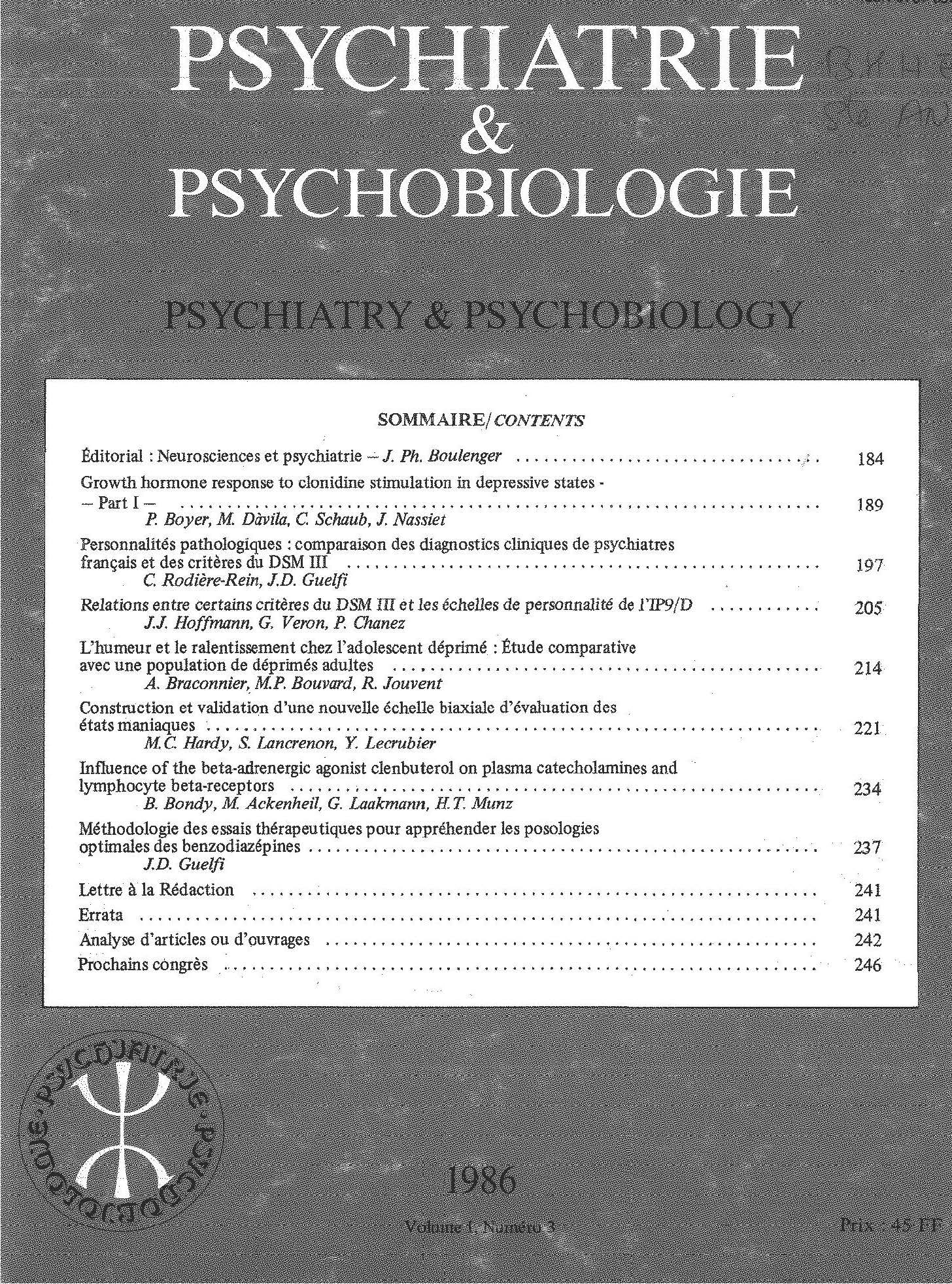Article contents
Perturbations Cognitives et Pathologie Anxieuse
Published online by Cambridge University Press: 28 April 2020
Résumé
L’analyse sémiologique de la pathologie anxieuse met en évidence la fréquence des troubles cognitifs associés tant au cours des accès d’angoisse-panique que dans les états d’anxiété plus chroniques de type généralisé ou phobique. Au cours des crises d’angoisse, la survenue de symptômes qualifiés de «psycho-sensoriels» n’est pas rare: modifications d’intensité de diverses modalités sensorielles, altérations du cours de la pensée et de la sensation du temps écoulé, perception anormale de son propre corps (dépersonnalisation) et du milieu environnant (déréalisation). A ces troubles «perceptifs», voisins de ceux observés dans certaines formes d’épilepsie temporale, s’ajoute une focalisation extrême de l’attention sur un danger subjectif contre laquelle les données de la réalité ambiante ou de l’expérience passée paraissent ne plus avoir d’influence. Dans l’anxiété généralisée chronique, l’attention apparaît au contraire plus labile, l’hypervigilance entraînant une exagération de l’attention spontanée et un affaiblissement de l’attention volontaire qui pourraient rendre compte des difficultés de concentration et des troubles de la mémoire à court terme dont se plaignent fréquemment ces patients. Ces troubles de «l’intelligence» font partie des «stigmates psychasthéniques» qui, pour Pierre Janet, résultent de la baisse de tension psychologique, mécanisme psychopathologique commun à la plupart des syndromes qui seront désignés plus tard sous le nom d’états névrotiques ou de troubles anxieux. Malgré I intérêt de telles hypothèses, l’étude des fonctions cognitives n’a fait l’objet jusqu’alors que d’un développement limité dans le champ de la psychiatrie, et les quelques études réalisées chez des volontaires présentant des degrés variables d’anxiété-trait posent le problème de leur extrapolation aux situations pathologiques. L’intérêt de ces explorations neuropsychologiques est évident et devrait être développé, tant en ce qui concerne les grandes fonctions cognitives (attention, mémoire, perception sensorielle) qu’en ce qui concerne le fonctionnement spécifique des deux hémispheres cérébraux dont l’influence sur la régulation des processus émotionnels apparaît inégale.
Summary
Semiological analysis of pathological anxiety points to the frequency of associated cognitive disorders, during panic attacks as well as in the more chronic generalized or phobic anxiety disorders. During panic attacks, the occurrence of symptoms described as “psychosensory” is not uncommon; changes in intensity of different sensory forms, alterations in the train of thought and in the notion of time lapse, abnormal perception of one's own body (depersonalisation) and of surroundings (unreality). To these “perceptive” disorders which are similar to those observed in certain forms of temporal epilepsy, can be added the intense focusing of the attention on a subjective danger, against which the facts of surrounding reality or past experience seem no longer to have any effect. In chronic generalized anxiety on the contrary, attention seems to be more unstable, hypervigilance bringing on the exaggeration of spontaneous attention and the weakening of determined attention which may explain the difficulty to concentrate and problems with short-term memory the patients frequently complain of. These disorders of the “intelligence” form part of the “psychasthenic scars”, which for Pierre Janet, were due to a lowering of psychological tension, a psychopatholocal mechanism that is common to most syndromes, later to be labelled neurotic states or panic disorders. In spite of the interest pertaining to such hypotheses, the study of cognitive functions has only until now been the object of a timid development in the field of psychiatry, and the few studies undertaken on volunteers with varying degrees of anxiety pose the problem of their extrapolation to pathological situations. The interest pertaining to these neuropsychological explorations is obvious and should be developed in regard to the main cognitive functions (attention, memory, sensorial perception); as well as regarding the specific function of the two cerebral hemispheres, whose influence on the regulation of emotional processes appears to be uneven.
Keywords
- Type
- Research Article
- Information
- Psychiatry and Psychobiology , Volume 3 , Issue S2: Aspects cliniques et cognitifs de l'anxiété Paris, 28 Janvier 1988 , 1988 , pp. 125s - 129s
- Copyright
- Copyright © European Psychiatric Association 1988
References
Références
- 1
- Cited by



Comments
No Comments have been published for this article.